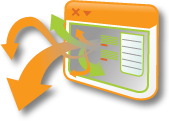I’m currently reading Shaping Things, by Bruce Sterling. It’s a brilliant essay examining the relationships humans have with objects. Specifically, it looks at the way designers interact with objects and how what it means to be an object and a designer are changing. The reason I’m writing about it here is that there is a fundamental shift not just in the way we experience objects, but in the way objects “experience” us.
Sterling points out that with the advent of barcodes and (subsequently) “arphids,” our objects receive an identity. With an identity, we are able to track the objects we have relationships with as they move through their lifecycle. Conversely, our objects are gaining more and more in the way of sensors. They are becoming more aware of the context in which they are used. Some of them, are becoming more aware of those using them.
It’s easy to see this phenomenon when you look at your computer. There is an entire collection of data dedicated to your preferences – screen resolution, favorite websites, font sizes, etc.. But your browser also maintains a history of sites visited (until you explicitly clear the list). The more recent browsers even show you a prioritized list of the sites you visit most often. Most applications remember the files you most recently opened. My computer even offers to remember usernames and passwords for me.
You can also see this in action in other systems. My car stores things like seat location and radio favorites on my copy of the keys. When the car is opened with my key, the seat moves into place and my favorites are loaded into the preset buttons on the radio. If I’m ever in an accident, my car will have a complete recording of the most telling data about my driving just prior to the incident.
My phone remembers the people I call most often. It remembers the wireless networks I belong to and logs me in automatically. There’s even an add-on for the phone that will measure and store your insulin levels.
With increasing frequency and fidelity, our objects are listening to us. If we’re smart, we’ll find a way to get them to tell us more about ourselves. If we can pull that data from our objects, we can find ways to make both of us better.

